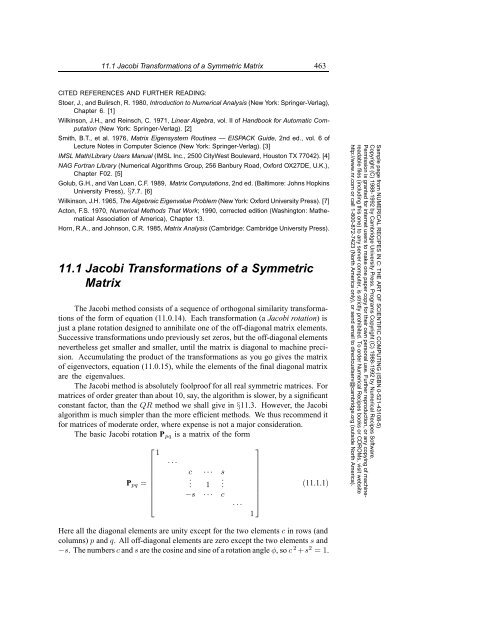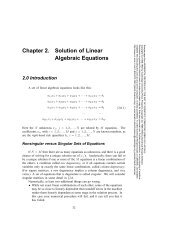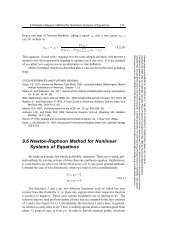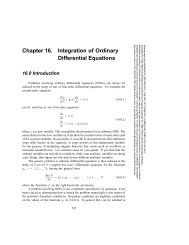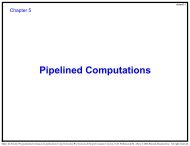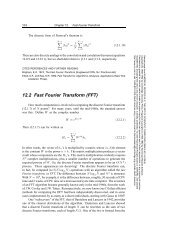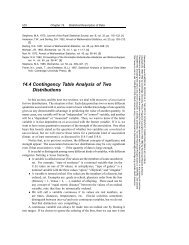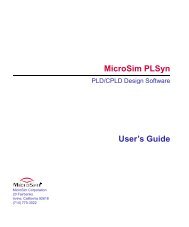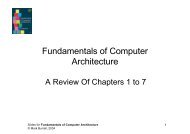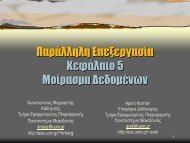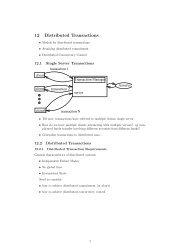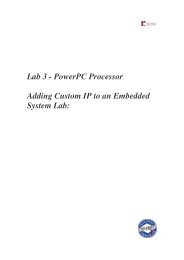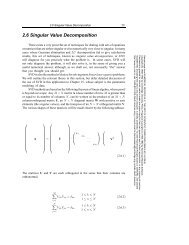11.1 Jacobi Transformations of a Symmetric Matrix
11.1 Jacobi Transformations of a Symmetric Matrix
11.1 Jacobi Transformations of a Symmetric Matrix
You also want an ePaper? Increase the reach of your titles
YUMPU automatically turns print PDFs into web optimized ePapers that Google loves.
<strong>11.1</strong> <strong>Jacobi</strong> <strong>Transformations</strong> <strong>of</strong> a <strong>Symmetric</strong> <strong>Matrix</strong> 463CITED REFERENCES AND FURTHER READING:Stoer, J., and Bulirsch, R. 1980, Introduction to Numerical Analysis (New York: Springer-Verlag),Chapter 6. [1]Wilkinson, J.H., and Reinsch, C. 1971, Linear Algebra, vol. II <strong>of</strong> Handbook for Automatic Computation(New York: Springer-Verlag). [2]Smith, B.T., et al. 1976, <strong>Matrix</strong> Eigensystem Routines — EISPACK Guide, 2nd ed., vol. 6 <strong>of</strong>Lecture Notes in Computer Science (New York: Springer-Verlag). [3]IMSL Math/Library Users Manual (IMSL Inc., 2500 CityWest Boulevard, Houston TX 77042). [4]NAG Fortran Library (Numerical Algorithms Group, 256 Banbury Road, Oxford OX27DE, U.K.),Chapter F02. [5]Golub, G.H., and Van Loan, C.F. 1989, <strong>Matrix</strong> Computations, 2nd ed. (Baltimore: Johns HopkinsUniversity Press), §7.7. [6]Wilkinson, J.H. 1965, The Algebraic Eigenvalue Problem (New York: Oxford University Press). [7]Acton, F.S. 1970, Numerical Methods That Work; 1990, corrected edition (Washington: MathematicalAssociation <strong>of</strong> America), Chapter 13.Horn, R.A., and Johnson, C.R. 1985, <strong>Matrix</strong> Analysis (Cambridge: Cambridge University Press).<strong>11.1</strong> <strong>Jacobi</strong> <strong>Transformations</strong> <strong>of</strong> a <strong>Symmetric</strong><strong>Matrix</strong>The <strong>Jacobi</strong> method consists <strong>of</strong> a sequence <strong>of</strong> orthogonal similarity transformations<strong>of</strong> the form <strong>of</strong> equation (11.0.14). Each transformation (a <strong>Jacobi</strong> rotation) isjust a plane rotation designed to annihilate one <strong>of</strong> the <strong>of</strong>f-diagonal matrix elements.Successive transformations undo previously set zeros, but the <strong>of</strong>f-diagonal elementsnevertheless get smaller and smaller, until the matrix is diagonal to machine precision.Accumulating the product <strong>of</strong> the transformations as you go gives the matrix<strong>of</strong> eigenvectors, equation (11.0.15), while the elements <strong>of</strong> the final diagonal matrixare the eigenvalues.The <strong>Jacobi</strong> method is absolutely foolpro<strong>of</strong> for all real symmetric matrices. Formatrices <strong>of</strong> order greater than about 10, say, the algorithm is slower, by a significantconstant factor, than the QR method we shall give in §11.3. However, the <strong>Jacobi</strong>algorithm is much simpler than the more efficient methods. We thus recommend itfor matrices <strong>of</strong> moderate order, where expense is not a major consideration.The basic <strong>Jacobi</strong> rotation P pq is a matrix <strong>of</strong> the form⎡1P pq =⎢⎣···c ··· s. .. 1 .−s ··· c···⎤⎥⎦1(<strong>11.1</strong>.1)Sample page from NUMERICAL RECIPES IN C: THE ART OF SCIENTIFIC COMPUTING (ISBN 0-521-43108-5)Copyright (C) 1988-1992 by Cambridge University Press. Programs Copyright (C) 1988-1992 by Numerical Recipes S<strong>of</strong>tware.Permission is granted for internet users to make one paper copy for their own personal use. Further reproduction, or any copying <strong>of</strong> machinereadablefiles (including this one) to any server computer, is strictly prohibited. To order Numerical Recipes books or CDROMs, visit websitehttp://www.nr.com or call 1-800-872-7423 (North America only), or send email to directcustserv@cambridge.org (outside North America).Here all the diagonal elements are unity except for the two elements c in rows (andcolumns) p and q. All <strong>of</strong>f-diagonal elements are zero except the two elements s and−s. The numbers c and s are the cosine and sine <strong>of</strong> a rotation angle φ,soc 2 +s 2 =1.
464 Chapter 11. EigensystemsA plane rotation such as (<strong>11.1</strong>.1) is used to transform the matrix A according toA ′ = P T pq · A · P pq (<strong>11.1</strong>.2)Now, P T pq · A changes only rows p and q <strong>of</strong> A, while A · P pq changes only columnsp and q. Notice that the subscripts p and q do not denote components <strong>of</strong> P pq ,butrather label which kind <strong>of</strong> rotation the matrix is, i.e., which rows and columns itaffects. Thus the changed elements <strong>of</strong> A in (<strong>11.1</strong>.2) are only in the p and q rowsand columns indicated below:⎡··· a ′ 1p ··· a ′ ⎤1q ···. . . .a ′ p1 ··· a ′ pp ··· a ′ pq ··· a ′ pnA ′ =. . . .a ′ q1 ··· a ′ qp ··· a ′ qq ··· a ′ qn⎢⎣ . . . . ⎥. . . .⎦··· a ′ np ··· a ′ nq ···(<strong>11.1</strong>.3)Multiplying out equation (<strong>11.1</strong>.2) and using the symmetry <strong>of</strong> A, we get the explicitformulasa ′ rp = ca rp − sa rqa ′ rq = ca rq + sa rpr ≠ p, r ≠ q (<strong>11.1</strong>.4)a ′ pp = c2 a pp + s 2 a qq − 2sca pq (<strong>11.1</strong>.5)a ′ qq = s2 a pp + c 2 a qq +2sca pq (<strong>11.1</strong>.6)a ′ pq =(c 2 − s 2 )a pq + sc(a pp − a qq ) (<strong>11.1</strong>.7)The idea <strong>of</strong> the <strong>Jacobi</strong> method is to try to zero the <strong>of</strong>f-diagonal elements by aseries <strong>of</strong> plane rotations. Accordingly, to set a ′ pq =0, equation (<strong>11.1</strong>.7) gives thefollowing expression for the rotation angle φθ ≡ cot 2φ ≡ c2 − s 22scIf we let t ≡ s/c, the definition <strong>of</strong> θ can be rewritten= a qq − a pp2a pq(<strong>11.1</strong>.8)t 2 +2tθ − 1=0 (<strong>11.1</strong>.9)The smaller root <strong>of</strong> this equation corresponds to a rotation angle less than π/4in magnitude; this choice at each stage gives the most stable reduction. Using theform <strong>of</strong> the quadratic formula with the discriminant in the denominator, we canwrite this smaller root asSample page from NUMERICAL RECIPES IN C: THE ART OF SCIENTIFIC COMPUTING (ISBN 0-521-43108-5)Copyright (C) 1988-1992 by Cambridge University Press. Programs Copyright (C) 1988-1992 by Numerical Recipes S<strong>of</strong>tware.Permission is granted for internet users to make one paper copy for their own personal use. Further reproduction, or any copying <strong>of</strong> machinereadablefiles (including this one) to any server computer, is strictly prohibited. To order Numerical Recipes books or CDROMs, visit websitehttp://www.nr.com or call 1-800-872-7423 (North America only), or send email to directcustserv@cambridge.org (outside North America).sgn(θ)t =|θ| + √ θ 2 +1(<strong>11.1</strong>.10)
<strong>11.1</strong> <strong>Jacobi</strong> <strong>Transformations</strong> <strong>of</strong> a <strong>Symmetric</strong> <strong>Matrix</strong> 465If θ is so large that θ 2 would overflow on the computer, we set t =1/(2θ).now follows thatItc =1√t2 +1(<strong>11.1</strong>.11)s = tc (<strong>11.1</strong>.12)When we actually use equations (<strong>11.1</strong>.4)–(<strong>11.1</strong>.7) numerically, we rewrite themto minimize round<strong>of</strong>f error. Equation (<strong>11.1</strong>.7) is replaced bya ′ pq =0 (<strong>11.1</strong>.13)The idea in the remaining equations is to set the new quantity equal to the oldquantity plus a small correction. Thus we can use (<strong>11.1</strong>.7) and (<strong>11.1</strong>.13) to eliminatea qq from (<strong>11.1</strong>.5), givingSimilarly,where τ (= tan φ/2) is defined bya ′ pp = a pp − ta pq (<strong>11.1</strong>.14)a ′ qq = a qq + ta pq (<strong>11.1</strong>.15)a ′ rp = a rp − s(a rq + τa rp ) (<strong>11.1</strong>.16)a ′ rq = a rq + s(a rp − τa rq ) (<strong>11.1</strong>.17)τ ≡s1+c(<strong>11.1</strong>.18)One can see the convergence <strong>of</strong> the <strong>Jacobi</strong> method by considering the sum <strong>of</strong>the squares <strong>of</strong> the <strong>of</strong>f-diagonal elementsEquations (<strong>11.1</strong>.4)–(<strong>11.1</strong>.7) imply thatS = ∑ |a rs | 2 (<strong>11.1</strong>.19)r≠sS ′ = S − 2|a pq | 2 (<strong>11.1</strong>.20)(Since the transformation is orthogonal, the sum <strong>of</strong> the squares <strong>of</strong> the diagonalelements increases correspondingly by 2|a pq | 2 .) The sequence <strong>of</strong> S’s thus decreasesmonotonically. Since the sequence is bounded below by zero, and since we canchoose a pq to be whatever element we want, the sequence can be made to convergeto zero.Sample page from NUMERICAL RECIPES IN C: THE ART OF SCIENTIFIC COMPUTING (ISBN 0-521-43108-5)Copyright (C) 1988-1992 by Cambridge University Press. Programs Copyright (C) 1988-1992 by Numerical Recipes S<strong>of</strong>tware.Permission is granted for internet users to make one paper copy for their own personal use. Further reproduction, or any copying <strong>of</strong> machinereadablefiles (including this one) to any server computer, is strictly prohibited. To order Numerical Recipes books or CDROMs, visit websitehttp://www.nr.com or call 1-800-872-7423 (North America only), or send email to directcustserv@cambridge.org (outside North America).Eventually one obtains a matrix D that is diagonal to machine precision. Thediagonal elements give the eigenvalues <strong>of</strong> the original matrix A, sinceD = V T · A · V (<strong>11.1</strong>.21)
466 Chapter 11. EigensystemswhereV = P 1 · P 2 · P 3 ··· (<strong>11.1</strong>.22)the P i ’s being the successive <strong>Jacobi</strong> rotation matrices. The columns <strong>of</strong> V are theeigenvectors (since A · V = V · D). They can be computed by applyingV ′ = V · P i (<strong>11.1</strong>.23)at each stage <strong>of</strong> calculation, where initially V is the identity matrix.equation (<strong>11.1</strong>.23) isv ′ rs = v rs (s ≠ p, s ≠ q)In detail,v ′ rp = cv rp − sv rqv ′ rq = sv rp + cv rq(<strong>11.1</strong>.24)We rewrite these equations in terms <strong>of</strong> τ as in equations (<strong>11.1</strong>.16) and (<strong>11.1</strong>.17)to minimize round<strong>of</strong>f.The only remaining question is the strategy one should adopt for the order inwhich the elements are to be annihilated. <strong>Jacobi</strong>’s original algorithm <strong>of</strong> 1846 searchedthe whole upper triangle at each stage and set the largest <strong>of</strong>f-diagonal element to zero.This is a reasonable strategy for hand calculation, but it is prohibitive on a computersince the search alone makes each <strong>Jacobi</strong> rotation a process <strong>of</strong> order N 2 instead <strong>of</strong> N.A better strategy for our purposes is the cyclic <strong>Jacobi</strong> method, where oneannihilates elements in strict order. For example, one can simply proceed downthe rows: P 12 , P 13 , ..., P 1n ; then P 23 , P 24 , etc. One can show that convergenceis generally quadratic for both the original or the cyclic <strong>Jacobi</strong> methods, fornondegenerate eigenvalues. One such set <strong>of</strong> n(n − 1)/2 <strong>Jacobi</strong> rotations is calleda sweep.The program below, based on the implementations in [1,2], uses two furtherrefinements:• In the first three sweeps, we carry out the pq rotation only if |a pq | >ɛfor some threshold valuewhere S 0 is the sum <strong>of</strong> the <strong>of</strong>f-diagonal moduli,ɛ = 1 S 05 n 2 (<strong>11.1</strong>.25)S 0 = ∑ |a rs | (<strong>11.1</strong>.26)r
<strong>11.1</strong> <strong>Jacobi</strong> <strong>Transformations</strong> <strong>of</strong> a <strong>Symmetric</strong> <strong>Matrix</strong> 467In the following routine the n×n symmetric matrix a is stored as a[1..n][1..n]. On output, the superdiagonal elements <strong>of</strong> a are destroyed, but the diagonaland subdiagonal are unchanged and give full information on the original symmetricmatrix a. The vector d[1..n] returns the eigenvalues <strong>of</strong> a. During the computation,it contains the current diagonal <strong>of</strong> a. The matrix v[1..n][1..n] outputs thenormalized eigenvector belonging to d[k] in its kth column. The parameter nrot isthe number <strong>of</strong> <strong>Jacobi</strong> rotations that were needed to achieve convergence.Typical matrices require 6 to 10 sweeps to achieve convergence, or 3n 2 to 5n 2<strong>Jacobi</strong> rotations. Each rotation requires <strong>of</strong> order 4n operations, each consisting<strong>of</strong> a multiply and an add, so the total labor is <strong>of</strong> order 12n 3 to 20n 3 operations.Calculation <strong>of</strong> the eigenvectors as well as the eigenvalues changes the operationcount from 4n to 6n per rotation, which is only a 50 percent overhead.#include #include "nrutil.h"#define ROTATE(a,i,j,k,l) g=a[i][j];h=a[k][l];a[i][j]=g-s*(h+g*tau);\a[k][l]=h+s*(g-h*tau);void jacobi(float **a, int n, float d[], float **v, int *nrot)Computes all eigenvalues and eigenvectors <strong>of</strong> a real symmetric matrix a[1..n][1..n]. Onoutput, elements <strong>of</strong> a above the diagonal are destroyed. d[1..n] returns the eigenvalues <strong>of</strong> a.v[1..n][1..n] is a matrix whose columns contain, on output, the normalized eigenvectors <strong>of</strong>a. nrot returns the number <strong>of</strong> <strong>Jacobi</strong> rotations that were required.{int j,iq,ip,i;float tresh,theta,tau,t,sm,s,h,g,c,*b,*z;b=vector(1,n);z=vector(1,n);for (ip=1;ip
468 Chapter 11. Eigensystems}else if (fabs(a[ip][iq]) > tresh) {h=d[iq]-d[ip];if ((float)(fabs(h)+g) == (float)fabs(h))t=(a[ip][iq])/h;t =1/(2θ)else {theta=0.5*h/(a[ip][iq]); Equation (<strong>11.1</strong>.10).t=1.0/(fabs(theta)+sqrt(1.0+theta*theta));if (theta < 0.0) t = -t;}c=1.0/sqrt(1+t*t);s=t*c;tau=s/(1.0+c);h=t*a[ip][iq];z[ip] -= h;z[iq] += h;d[ip] -= h;d[iq] += h;a[ip][iq]=0.0;for (j=1;j
11.2 Reduction <strong>of</strong> a <strong>Symmetric</strong> <strong>Matrix</strong> to Tridiagonal Form 469}}for (j=i+1;j= p) p=d[k=j];if (k != i) {d[k]=d[i];d[i]=p;for (j=1;j


